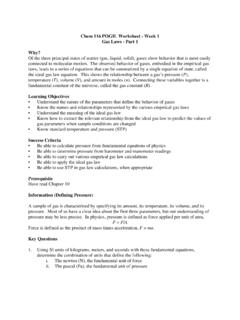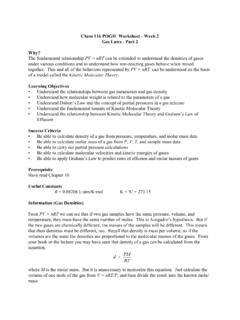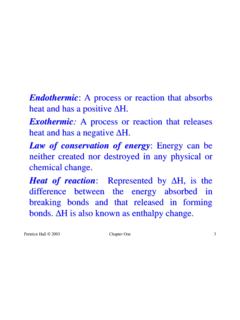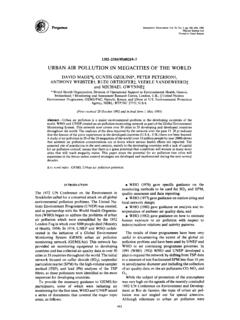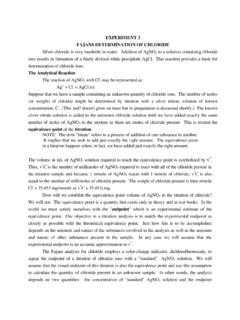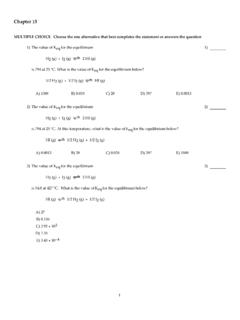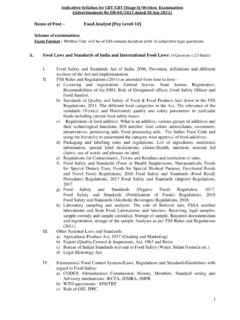Transcription of Solubility of CaSO4
1 Solubility of CaSO4 Experiment 8 Major Concepts and Learning Goals Application of the Solubility product constant (Ksp) Saturated solutions Le Chatlier s Principle/Common ion effect Activities and activity coefficients Ion selective electrodes Calibration curves Laboratory Task Produce a calibration curve using standard solutions of CaNO3 Measure the [Ca2+] of three different solutions 1) a saturated solution of CaSO4 in H2O 2) a saturated solution of CaSO4 in M KNO3 3) a saturated solution of CaSO4 in M Na2SO4 Observe the effect of ionic strength on the [Ca2+] by comparing the results of solution 1 and 2. Observe the effect of the Na2SO4 on the [Ca2+] (common ion effect). Introduction The Solubility of CaSO4 at 25 C is described by the following reaction and equilibrium CaSO4 (s) Ca2+ + SO42- Ksp( CaSO4 ) = [Ca2+][SO42-] = 10-5 eq.
2 1 In words, this equilibrium expression implies that the product of the calcium ion concentration and the sulfate ion concentration can be no larger than 10-5 in any aqueous solution. Saturated solutions Any aqueous solution in which the product of the calcium ion concentration and the sulfate ion concentration is about 10-5 is said to be a saturated CaSO4 solution. If a little more Ca2+ or SO42- is added to a saturated CaSO4 solution the equilibrium will shift to the left to form solid CaSO4 and the value of the product of the calcium ion concentration and the sulfate ion concentration would be restored to about 10-5. This statement is the basis of Le Chatlier s Principle. When an equilibrium position of a reaction is disturbed, a new equilibrium position will be established by shifting the reaction in a direction that alleviates the stress caused by the disturbance Saturated solutions can be prepared by a variety of methods.
3 In this experiment the first saturated solution has been prepared by adding solid CaSO4 to purified water (the water comes from a purification system that includes a carbon filter, an ion-exchange resin and a UV lamp). The solution was mixed for several days and allowed to settle and reach equilibrium for several weeks. Then the solution was filtered to remove any suspended CaSO4 particles that did not dissolve or settle to the bottom. Because the only source of the calcium ions and sulfate ions come from the dissolution of CaSO4 , [Ca2+] = [SO42-]. In fact, the same statement can also be made for the second saturated solution, since KNO3 is not a source of Ca2+ or SO42-. When we ignore the impact of ionic strength, the [Ca2+] and [SO42-] concentrations of these first two saturated solutions are expected to be about 10-3 M, based on the literature Ksp value for CaSO4 {( 10-5)1/2}.
4 Le Chatlier s Principle and the Common Ion Effect One general case in which Le Chatlier s principle can be applied is when the solution contains a soluble salt of an ion that is in common with the insoluble salt in question. This is the case in the third saturated solution; CaSO4 in dissolved M Na2SO4. In this solution there are two sources of the sulfate ion; the Na2SO4 and the CaSO4 . The SO42- coming from the Na2SO4 is M, because Na2SO4 is a completely soluble salt. The sulfate ion coming from the CaSO4 is equal to the calcium ion concentration. Thus, Ksp = [Ca2+] ([SO42-] CaSO4 + + [SO42-]Na2SO4) = 10-5 Letting [Ca2+] = x, we arrive at Ksp = x (x + ) = 10-5 If we assume x <<< M, then Ksp = x = 10-5 and [Ca2+] = 10-4 M, This is considerably lower than the first saturated solution. It is also worth pointing out that our solution to the problem verifies that our stated assumption was valid.
5 This lowering of the [Ca2+] is due to the common ion effect. Activities and Activity Coefficients In reality, equilibria are affected by the concentration of ions, any ions, in solution. The ionic strength () is used as a measure of the total ion concentration of a solution. It is calculated by incorporating each of the i ionic species in solution into the following equation, where C is the concentration in mol/L and Z is the charge on the ion. = (CiZi2) So, why does the ionic strength matter? Well let s look at the CaSO4 equilibrium as an example. The ionic strengths of the saturated solution 2 and 3 are considerably greater than that of saturated solution 1. Initial estimates of the ionic strength of these three saturated solutions (these are initial estimates because the concentrations of [Ca2+] and [SO42-] were determined ignoring the impact of ionic strength) Saturated solution 1 = ([Ca2+](2)2 + [SO42-](-2)2)) = (5 10-3(2)2 + 10-3(-2)2)) = M Saturated solution 2 = ([K+](1)2 + [NO3-](-1)2 + [Ca2+](2)2 + [SO42-](-2)2)) = ( (1)2 + (-1)2 + 5 10-3(2)2 + 10-3(2)2)) = M Saturated solution 3 = ([Na+](1)2 + [SO42-](-2)2) + [Ca2+](2)2) = ( (1)2 + (-2)2 + 10-4(2)2 ) = M Electrostatic interactions between the negative ions and the Ca2+ ions in solution cause the formation of an ion cloud around the Ca2+ ions.
6 The larger the ionic strength of the solution the greater the radius of this ion cloud. A similar ion cloud forms around the SO42- ions from the positive ions in solution. The size of the ion clouds about Ca2+ and SO42- defines the energetics associated with these ions finding each other in solution and forming CaSO4 (s). Thus, the [Ca2+] and the [SO42-] in the second saturated solution would be expected to be significantly greater than 10-3 M, and in the third saturated solution the [Ca2+] would be expected to be greater than 10-4 M. Mathematically, the impact of ionic strength is accounted for by introducing the concept of ion activity, A. The activity of an ion can be thought of as its effective concentration and is given by product of its concentration and activity coefficient, . The activity coefficient depends upon the size of the ion, its charge, and the ionic strength of the solution.
7 For example: ACa2+ = [Ca2+] Ca+ The activity coefficient can be calculated using the Debye-Huckle equation. The most important concept to appreciate in terms of activities is that the definition of the equilibrium expression that we first learned and used (eq. 1) is only a model. It works very well at low ionic strengths, where the activity coefficients are close to unity, but breaks down at higher ionic strengths. The more universal model expresses the equilibrium constants in terms of activities. Equation 1 becomes Ksp( CaSO4 ) = ACa2+ASO42- = [Ca2+]Ca2+[SO42-]SO42- = 10-5 eq. 2 Ca2+ and SO42- for solution 2 are less than for solution 1 because the ionic strength of solution 2 is greater than the ionic strength of solution 1, and as a result [Ca2+]and[SO42-] must be larger in solution 2 for both solutions to satisfy the Ksp expression. However, it is important to appreciate that the ionic strength of solution 1 is large enough to have an impact on the Solubility .
8 So, even for this solution, it is expected that the Solubility will be significantly larger than the mM predicted above. Ion- Selective Electrodes Ion-selective electrodes are electrochemical cells that have been carefully crafted into a probe that is useful for measuring the activity of a specific ion in solution. An ion-selective electrode most often consists of two reference electrodes, which give a constant potential. The two reference electrodes are electrically linked via a voltmeter and a salt bridge through the solution being measured. The salt bridge consists of a membrane between the solution being measured and the inner reference electrode solution. This membrane is made of a unique material that preferentially allows the ion of interest to partially penetrate the membrane. This partial penetration leads to the development of a junction potential, the magnitude of which depends entirely on the activity of the ion in the solution being measured.
9 The Ca2+ selective electrode used in this application contains a membrane that preferentially chelates Ca2+. The potential measured by the voltmeter depends upon the potential at each of the reference electrodes and the junction potential. The potential of the reference electrodes is constant and junction potential is only influenced by the activity of the Ca2+ in the solution being measure. Ecell = constant + log ACa2+ = constant + log [Ca2+]Ca2+ Typically, one would measure the voltage of several standard Ca2+ solutions in the range of M Ca2+ at a constant ionic strength. To measure the concentration of [Ca2+], the usual procedure is to measure the potentials of the standard solutions with a Ca2+ selective electrode and use the data to produce a calibration plot. To make the analysis of the data straightforward and simple all of the standards and samples are prepared using an electrolyte of high ionic strength.
10 As a result, all of the solutions have the same ionic strength and, as a result, the activity coefficient becomes a constant. Applying the rule of logs log AB = log A + log B Ecell = constant + log [Ca2+]Ca2+ Becomes Ecell = constant + log [Ca2+] + log Ca2+ Ecell = constant1 + log [Ca2+] + constant2 Combining constants Ecell = constant + log [Ca2+] Then, a calibration plot is produced by plotting the cell potential as a function of the log [Ca2+]. Then, your samples are prepared by diluting it quantitatively with the same electrolyte. This ensures that the ionic strength of your sample solutions match that of your standards. Experimental Note: In this experiment once you dilute the saturated solutions, they will no longer be saturated. Since all of the left over CaSO4 will be removed by filtration, the [Ca2+] in each of the samples is reduced by a known dilution factor, which will be taken into account during your calculations.


